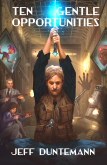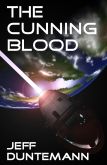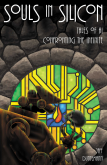Earlier this afternoon, after literally three and a half years, I finished the first draft of my first new novel since 2012. Oh, there’s lots still to be done; editing, finding a cover, thinking about prices and promotions, all the usual. But without a first draft, none of the rest of it matters.
The novel is Dreamhealer. It’s what I call “suburban fantasy,” by which I mean no grittier than Chicago’s suburbs. The action spans Elk Grove Village, Des Plaines, Mount Prospect, Park Ridge, Arlington Heights, and South Barrington. Oh, and the subtle planes of dreams, imagination, and memory. Here’s my logline:
A lucid dreamer discovers he can enter and heal the nightmares of others, and declares war on the mysterious creatures living in the collective unconscious that create nightmares and then feast on the terror they evoke.
And the back-cover hook:
Meet Larry. He’s your worst nightmare’s worst nightmare.
It’s not entirely serious, though it’s not humor in the strictest sense. I was looking for a sort of Secret Life of Walter Mitty, played out in what the esotericists call the subtle planes, or the Akasha. By day, 51-year-old IT nerd Larry Kettelkamp maintains a room full of ancient PDP-8 minicomputers for a dying industrial bakery in the shadow of O’Hare Field. But by night, he busts nightmares. The thing is, nightmares aren’t some accidental consequence of human psychology. Nossir. They were invented 15,000 years ago. The inventors were creatures living in the collective unconscious, called archons. Archons feed on human emotion. One particularly powerful and nasty archon developed a scheme to keep himself and his minions well-fed: Scare the hell out of sleeping cavemen and harvest their terror as emotional energy. It worked well–until Larry, having read stacks of esoteric works touching on everything from Theosophy to Persian Dualism, figures out how to enter other people’s nightmares, banish the archons, and inoculate the dreamers against that particular nightmare. This process involves an ancient symbol (everybody loves ancient symbols, right?) that restores at least part of the ancient bicameral mind.
And then the Boss Archon decides that his scam is in jeopardy, and begins fighting back.
My goal is to publish it before the end of June, and in truth as soon as I can manage a cover and some editing. But in the meantime, to give you a flavor for what I’m doing, allow me to present Chapter 1 of Dreamhealer:
1: Larry
Larry Kettelkamp slipped out of his body and dove into dreamspace. There was no down and no up in dreamspace, only focus. He did not consciously choose the focus. The rational mind could focus only on itself. Those dreams-his personal dreams-were good and necessary, but they were for other nights.
Tonight, this night…was for war.
Slowly dreamspace coalesced into light and darkness. Tiny glints like stars lay in every direction. Each glint was a dreamer. Each dreamer lay at the center of an aura that was a dream. Each dream was a color: red for warm comfort; orange for pleasant wanderings; yellow for joyful exuberance; green for study and discovery; blue for anxiety, shame, and sadness; indigo for fury; violet for terror. What had been indistinct clouds grew sharper. Larry closed his rational eyes. He knew his deeper mind was choosing. He felt the decision when it was made, as the silent emergence of up, down, time, and motion.
Larry opened his rational eyes, and saw the nightmare his unconscious had chosen, burning in violet below him.
A man was falling from a great height. His silver hair whipped in the vertical wind as he thrashed with all his limbs. This, one of the commonest of nightmares, Larry had dealt with many times. He dipped one shoulder, stretched out his arms, and banked toward the dreamer. Below them lay the entire United States, still wrapped in night, its great cities and small towns jewels scattered across the velvet darkness. The two men were high enough that Larry could see the curvature of the Earth, the blue layer of atmosphere, and the bright arc of the approaching dawn in the east.
The dreamer clearly knew what the Earth looked like from 90,000 feet.
That was a clue from Larry’s unconscious, which he needed to trust as his navigator, even if it had no language and could only speak in hints and symbols. He had gotten fairly good at interpreting what his deeper mind sent up to guide him over the thirty-odd years he had been invading other people’s nightmares. Ten thousand nights and thirty thousand dreams had proven that the collective unconscious was indeed collective, and included a universal symbology and grammar.
The dreamer, eyes wide and mouth agape, watched Larry approach. He wore a dark blue business suit, jacket buttoned, wide tie flapping over one shoulder. Larry’s unconscious sent up the insight that he was highly educated and used to getting his own way. Falling dreams symbolized lives that were out of control. For such a man, that could be an overwhelming fear.
The fear wasoverwhelming, and where there was overwhelming fear, there were archons. Larry couldn’t yet see it, but the bitter reek of a feasting archon was everywhere. Over the past year they had gotten better at hiding from him. Later, later. Larry pulled himself up and crossed his legs beneath him, as though sitting taylor-style in empty air. The dreamer was an arm’s length away.
“Help me. Please help me,” the man said. His words were clear to Larry even against the blast of air past their ears. That was good: Dreamers who asked for help were easy to help. The man lived by reason rather than emotion.
Larry reached out his right hand. The man frowned, hesitated, then reached out his own hand and took it. At once the roar of air passing around them ceased, as did its chaotic motion. They still fell, but now in silence and stillness. Only the man’s tie continued to flap, in a wind that was no longer there.
Gotcha!
Larry released the dreamer’s hand. “My name is Larry Kettelkamp. I fix bad dreams. Take off your tie.”
The man pulled his legs up beneath him in imitation of Larry’s posture. “My tie?”
“It’s not a tie. Take it off. Then give it to me.”
The man glanced down at his tie, which still flapped over his right shoulder. He shrugged and reached up with both hands to undo the knot. The tie writhed in his hands like a live thing. It was still writhing as Larry took it in his right hand. Larry stared at the tie, gathered inner strength, focused his attention on the tie, and squeezed.
The tie screamed. As it screamed it melted, contracting and flowing into a pale, blank human figure as long as Larry’s forearm. It had no face, ears, or mouth, nor any other features. The scream was not sound, but a polyphonic disturbance appearing directly in his mind. He had wondered often if it was an expression of pain, fear or perhaps anger. His unconscious had given him no clues on that question.
No matter. “Begone, archon,” Larry said in a soft voice. The scream ceased, and the creature vanished. With it vanished the smell of fear.
The man squinted at Larry’ hands where the archon had been. He smiled. “Hey, thanks. What the hell was that?”
“Archon. Emotional parasite. It creates nightmares, and then feeds on the emotions that the nightmares cause.” Larry held out his hand again. “I’m Larry Kettelkamp. Tell me your name.”
The dreamer took Larry’s hand and shook it. “Erwin McKinley, Ph.D. Astrophysics. Did thirty years in satellite guidance and space navigation. Wrote the textbook on it.”
“This dream tells me you need to take control of your life.”
Erwin wrinkled his brow, and was silent for a few seconds. “Life? Do I have a life?” He sighed, and looked down past his knees. “My wife’s dead. I haven’t had a job in ten years. They just put my book out of print. My kids ignore me. I’ve been forgotten, pretty much.” He looked down again. “By the way, we’re still falling.”
Larry shook his head. “No, we’re not. We’re flying.”
“Flying?”
“Yes.” Larry reached over one shoulder to the backpack he always wore when he battled the archons. The end of something like a roll of cloth protruded from under the flap. He grasped it, pulled it out, and shook it. It unrolled to a long, narrow rectangle of deep blue, printed with the constellations and the pale band of the Milky Way. “Like Superman.” Larry handed the cape to Erwin. “Put it on.”
Erwin took the cape, chuckling. “Hey, I saw The Incredibles. ‘No capes.'”
Larry shrugged. “Stay away from aircraft. You’re in satellite guidance. You can manage that.”
Erwin took the cape’s two clasps and brought them around his neck, snapping them together. “I can.”
“Now let’s fly!”
Larry stretched out horizontally with his arms in front of him. Erwin followed suit. The rush of air returned, but was now a headwind that rustled Erwin’s cape.
“Look down there,” Larry said. Below them, across the shadowed vastness of North America, the jewels that were city lights had vanished. Instead they saw a dusting of softer green lights plus a few brighter ones in yellow-orange. “Every light you see is someone with an emotional connection to you.”
“Huh! Like friends? I don’t have that many friends. And most of the friends I have are in Omaha.”
“Not friends.” Larry stared down at the lights, listening to his unconscious for clues. “I think they’re people who’ve read your book, and liked it. They admire you, respect what you know, and learned from it.”
“Ha! I’ve sold a hundred thousand copies over the last twenty years! No other textbook on guidance and navigation ever got anywhere near that kind of sales. The publisher says it’s obsolete, even though I’ve updated it every few years. They won’t say the rest of it, but they’re all young punks and I can tell: They think I’m too old.”
Larry banked to the right, toward where a constellation of many yellow-orange spots dotted Omaha. Erwin evidently had more friends than he thought. “Well, they’re wrong. Screw ’em. Build a new life. Get the rights to your book back. Update it. Turn it into a seminar series. Give lectures. Don’t just lie around the house.”
Erwin nodded. He twisted his body back and forth, as though testing himself against the strength of the wind. “Flying, heh! I can do this!”
“You already are. In fact, you’ve been flying by proxy your whole career. Don’t stop now.” Larry felt more clues bubbling up from his deeper mind. He pointed with his right hand. “Down there, west of Omaha. Lincoln, I’d guess. See the bright yellow light?”
Erwin nodded.
“A woman lives there. She rejected you a long time ago. She changed her mind.”
“Lincoln? I don’t know any women in Lincoln. I haven’t lived there since I left home for MIT, and…wait a second! Diana?”
“I’m not getting her name, but it sounds right.”
“Diana Zaborski! That was over fifty years ago!” Erwin’s voice softened. “She told me I was too weird for words.”
Larry swallowed hard. Did he understand that or what? “So? Maybe you were. You’re not anymore. And maybe she grew up a little herself. Fifty years will do that.”
“I can’t imagine she likes me that much…”
Larry pointed again. “Look how bright her star is. Maybe you treated her better than the boys who came after you. So send her a card. A letter. Look her up on Facebook. Ask her to get in touch.”
Erwin was doing barrel rolls. “Yeeee-hah! I can! And I will! I’m…flying!” He turned skyward and did a tight spiral loop around Larry, before vanishing into the rising dawn.
Larry watched Erwin’s contrail drift eastward. He raised his right hand and made an ancient symbol in the air. “Erwin McKinley, go in peace. Build yourself a new life. You will never have this dream again.”













